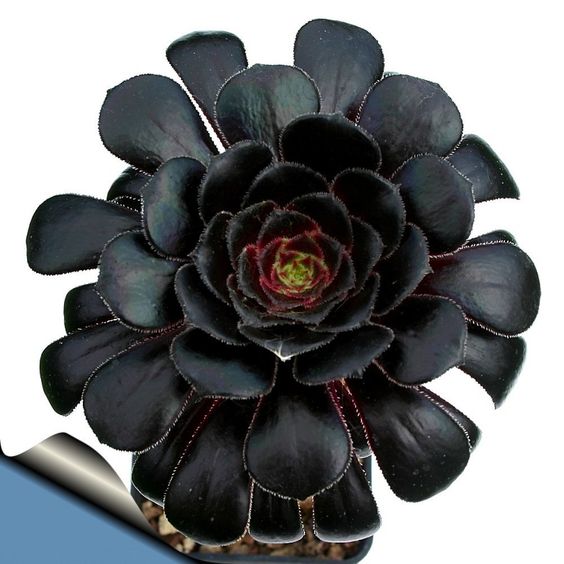These rare species of succulents and cacti are not only difficult to care for, but also difficult to find in the market. That is why they are rare species. Having a successful garden or nursery for rare species can be challenging because they are difficult to grow or take root easily. Or maybe they fail to produce seeds or even fail to propagate because of the few deviations they produce.
Thanks to tissue culture, the search for rare species of succulents and cacti is gradually becoming a reality. Let's take a look at these rare succulents.
Grapetoveria Superbum Variegated

Grapetoveria Superbum Variegated is one of the extremely rare exotic succulents available. This is a rare succulent plant that is very hardy, requiring lots of sunlight for them to look their best.
Graptopetalum pentandrum "Superbum" Variegata is a slow-growing plant that can grow up to 6 inches (15 cm) tall and spread up to 12 inches (30 cm) in diameter. In summer, it produces small pink or white star-shaped flowers that grow on tall stems.Conophytum Subglobosum

Do you think this is Lithops? Many people will think like you! Conophytum is a slow-growing and stemless succulent with small flowers with pyramidal petals.
This particular succulent plant is perennial and forms giant pea-head-shaped mounds. They need little water and enough sun or light shade.
They are also known as "living stones".
Haworthia Truncate

A very showy plant with a snow flake-like design at the top. Its leaves resemble a fan with a wrinkled surface and a transparent tip. Its asterisks are medium-sized and stemless, they proliferate slowly.
Haworthia is easy to grow, however, it is slow growing and can take several years to produce attractive heads.
Black rose Aeonium

Black rose is a common name for the plant Aeonium arboreum "Schwartzkopf", a succulent plant grown for its purplish-black leaves. The leaves are arranged in a rosette on a slender, light gray stem, giving the plant a dramatic appearance. Black rose plants are simple to care for if they are provided with full sun and well drained, but they require occasional watering and annual fertilization to look their best and reach their maximum height of 1 to 2 years. 3 feet.
Gymnocalycium Mihanovichii

Gymnocalycium Mihanovichii also known as Moon cactus or Hibotan cactus, belongs to desert habitats in different parts of South America; Argentina is correct.
This rare cactus comes from the genus Gymnocalycium of spherical cactus. These cacti are succulent plants that come in a variety of colors but do not have the chlorophyll needed to make plant sugars through photosynthesis.
Crassula Hemispherica

Crassula Hemisphaerica is best understood as a rare succulent with an exotic appearance. As the plant grows, you can expect it to turn from light green to dark green with dark areas around the well-shaped leaves and light green around the edges. When the plant flowers, expect small white flowers.
Echeveria Raindrops

Echeveria Raindrops is a succulent species in the family Crassulaceae and commonly known as Raindrops Echeveria.
Roses have round leaves. The asterisks are small, about 6 inches in diameter. These succulents grow singly but sometimes with several offsets.
The leaves are green with a hint of red at the edges. They also have green and sometimes blue bumps on the surface, which look like water droplets.
For this reason, the plant got its name. This succulent is a hybrid created by Dick Wright and is considered the smallest of the bumpy-leaved Echeverias.
Cotyledon Orbiculata Variegated

Cotyledon Orbiculata CV is a succulent plant, very beautiful leaves, small tree, very suitable for growing in pots and has certain decorative value. Orbiculata plants in pots can be placed next to televisions, computers to absorb radiation, and can also be grown indoors to absorb substances such as formaldehyde to purify the air. When we take care of Orbiculata CV, the potted soil is mainly a mixture of rotting leaves, peat soil and sawdust mixed well. During the growing period, it is best to control the temperature at about 15℃~25℃. High temperatures in summer can be cooled by spraying water to keep the principle of "dry and wet" watering. The following introduces in detail how to plant and care for Orbiculata.
Echeveria Compton Carousel

Echeveria Compton Carousel is a succulent species in the family Crassulaceae and commonly known as Variegated Hens and Chicks. This species is also known as Echeveria 'Lenore Dean' and has been a hybrid with its parents since the 1800s.
It is a very attractive looking succulent with tight asterisks up to 6 inches in height and diameter.
Titanopsis Calcarea

Titanopsis calcarea is native to Southwest and South Africa and is home to the genus Titanopsis, which includes about eight species of small shrubs. Its name comes from the top of the leaves, which mimic the texture of limestone with lichen. In fact, its natural environment is among limestone.
Agave victoriae-reginae


Titanopsis Calcarea

Titanopsis Calcarea are unusually rare plants. Typical names are: Concrete Leaf or Gem Plant. This rare exotic succulent is a wild-looking mesemb or mimic tree. The blue club-shaped leaves grow on top and have white bumpy warts.
Bromeliad Neoregelia

Bromeliad Neoregelia is a rare yellow succulent. This exotic succulent is compact and often forms a "cup" in the middle, where water and nutrient particles are gathered.
Echeveria Colorata Variegated

Echeveria Elegans Hybrid

Echeveria elegans Hybrid is a popular low-growing ornamental recreational plant. Its natural habitat is found mainly in Mexico, with some from Central America, South America, and the United States. Their natural habitat prefers rocky places, trees, and dry places. This species is one of the rarest succulents that can be either evergreen or deciduous.
Some rare succulents have evolved to mimic other plants or animals, such as rocks or even dried leaves, as a form of camouflage. There is a wide variety of shapes, sizes and colors among the rare succulents, making them a fascinating and fascinating group of plants to study and grow.








